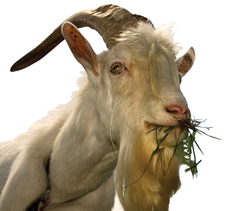Car NOT Goat
Programming Snapshot – Neural Networks

© Lead Image © Frantisek Hojdysz, 123RF.com
The well-known Monty Hall game show problem can be a rewarding maiden voyage for prospective statisticians. But is it possible to teach a neural network to choose between goats and cars with a few practice sessions?
Here's the problem: In a game show, a candidate has to choose from three closed doors; waiting behind these doors is a car, which is the main prize, a goat, and yet another goat (Figure 1). The candidate first picks a door, and then the presenter opens another, behind which there is a bleating goat. How is the candidate most likely to win the grand prize: Sticking with their choice or switching to the remaining closed door?
As has been shown [1] [2], the candidate is better off switching, because then they double their chances of winning. But how does a neural network learn the optimal game strategy while being rewarded for wins and punished for losses?
[...]
Buy this article as PDF
(incl. VAT)
Buy Linux Magazine
Subscribe to our Linux Newsletters
Find Linux and Open Source Jobs
Subscribe to our ADMIN Newsletters
Support Our Work
Linux Magazine content is made possible with support from readers like you. Please consider contributing when you’ve found an article to be beneficial.

News
-
Another Linux Malware Discovered
Russian hackers use Hyper-V to hide malware within Linux virtual machines.
-
TUXEDO Computers Announces a New InfinityBook
TUXEDO Computers is at it again with a new InfinityBook that will meet your professional and gaming needs.
-
SUSE Dives into the Agentic AI Pool
SUSE becomes the first open source company to adopt agentic AI with SUSE Enterprise Linux 16.
-
Linux Now Runs Most Windows Games
The latest data shows that nearly 90 percent of Windows games can be played on Linux.
-
Fedora 43 Has Finally Landed
The Fedora Linux developers have announced their latest release, Fedora 43.
-
KDE Unleashes Plasma 6.5
The Plasma 6.5 desktop environment is now available with new features, improvements, and the usual bug fixes.
-
Xubuntu Site Possibly Hacked
It appears that the Xubuntu site was hacked and briefly served up a malicious ZIP file from its download page.
-
LMDE 7 Now Available
Linux Mint Debian Edition, version 7, has been officially released and is based on upstream Debian.
-
Linux Kernel 6.16 Reaches EOL
Linux kernel 6.16 has reached its end of life, which means you'll need to upgrade to the next stable release, Linux kernel 6.17.
-
Amazon Ditches Android for a Linux-Based OS
Amazon has migrated from Android to the Linux-based Vega OS for its Fire TV.


